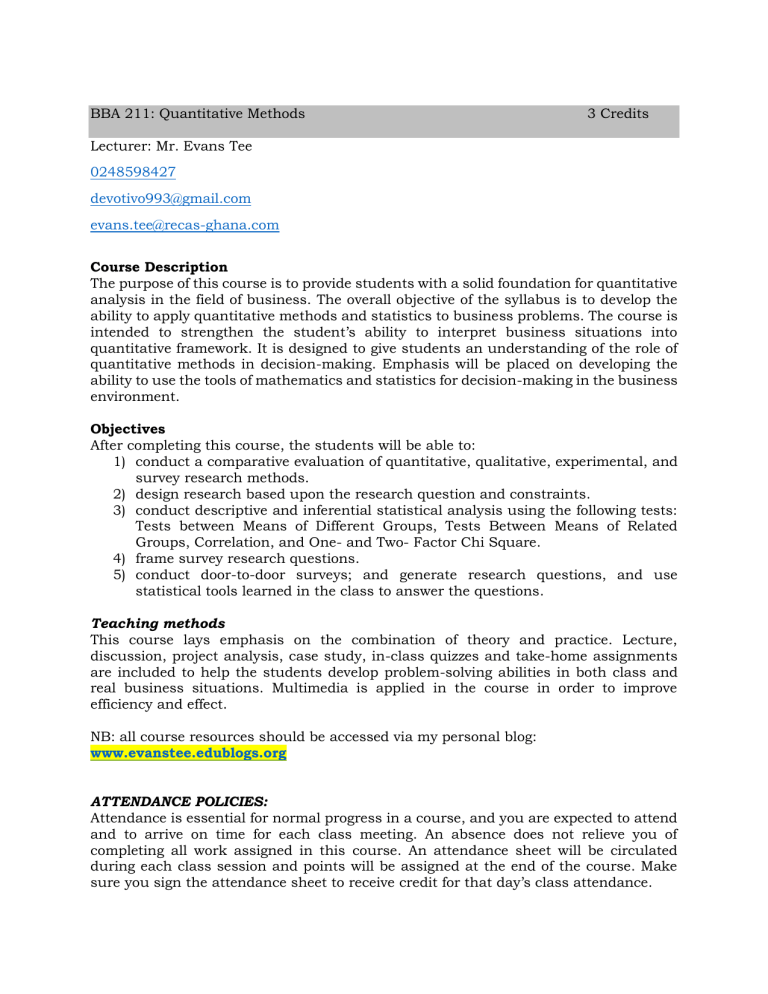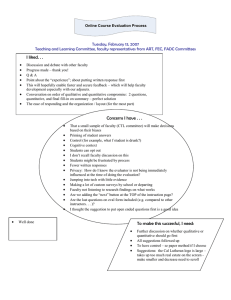
BBA 211: Quantitative Methods 3 Credits
Lecturer: Mr. Evans Tee
0248598427 devotivo993@gmail.com
evans.tee@recas-ghana.com
Course Description
The purpose of this course is to provide students with a solid foundation for quantitative analysis in the field of business. The overall objective of the syllabus is to develop the ability to apply quantitative methods and statistics to business problems. The course is intended to strengthen the student’s ability to interpret business situations into quantitative framework. It is designed to give students an understanding of the role of quantitative methods in decision-making. Emphasis will be placed on developing the ability to use the tools of mathematics and statistics for decision-making in the business environment.
Objectives
After completing this course, the students will be able to:
1) conduct a comparative evaluation of quantitative, qualitative, experimental, and survey research methods.
2) design research based upon the research question and constraints.
3) conduct descriptive and inferential statistical analysis using the following tests:
Tests between Means of Different Groups, Tests Between Means of Related
Groups, Correlation, and One- and Two- Factor Chi Square.
4) frame survey research questions.
5) conduct door-to-door surveys; and generate research questions, and use statistical tools learned in the class to answer the questions.
Teaching methods
This course lays emphasis on the combination of theory and practice. Lecture, discussion, project analysis, case study, in-class quizzes and take-home assignments are included to help the students develop problem-solving abilities in both class and real business situations. Multimedia is applied in the course in order to improve efficiency and effect.
NB: all course resources should be accessed via my personal blog: www.evanstee.edublogs.org
ATTENDANCE POLICIES:
Attendance is essential for normal progress in a course, and you are expected to attend and to arrive on time for each class meeting. An absence does not relieve you of completing all work assigned in this course. An attendance sheet will be circulated during each class session and points will be assigned at the end of the course. Make sure you sign the attendance sheet to receive credit for that day’s class attendance.
Course Outline
Sessions
Session 1
Session 2
Session 3
Session 4
Session 5
Session 6
Topics
Course Introduction and Overview
Syllabus, Course Goals and Structure
Introduction to Quantitative Analysis
Fundamentals of Probability
Probability Distributions
Random Variables
Applications in Businesses
Indices
Price indices and quantity indices
Constructing index numbers
Statistics
Design of Survey
Data Collection and presentation
Statistical measure of data
Mid Semester Examination Session 7
Session 8 Hypothesis Testing
One- and Two- Factor
Chi Square
Time Series and Forecasting Session 9
Session 10
Session 11
Session 12
Correlation Analysis
Simple Linear Regression
Multiple Linear Regression
Session 13 Linear Programming
Revision Week
Final Examination
Course Materials
1.
Waters, C. D. J. (2011). Methods for business. Financial Times Prentice Hall.
2.
Anderson, D. R. (2013). Quantitative methods for business (12thed.). Mason, OH:
South Western, Cengage Learning
3.
Creswell, J. W. (2014). Research design: qualitative, quantitative, and mixed methods approaches (4th ed.) Thousand Oaks, California; SAGE Publications
4.
Gupta, C. B. (2007). Quantitative methods. New Delhi: Asian Books
5.
Hair, J. F. (2015) Essentials of business research methods. (3rded.). New York:
Routledge.
6.
Mouhammed, A. H. (2015). Quantitative Methods for Business and Economics.
Taylor and Francis
7.
Morgan, D. L. (2014). Integrating qualitative and quantitative methods: a pragmatic approach. Thousand Oaks, California; SAGE Publications, Inc.
8.
Nardi, P. M. (2014). Doing survey research: a guide to quantitative methods
(3rded.). Boulder; London: Paradigm Publishers,
9.
Little, T. D. (2013). The Oxford handbook of quantitative methods. New York:
Oxford University Press.

